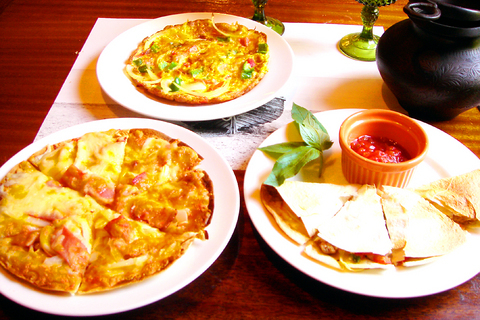A tapas restaurant in Taiwan can generally head in either of two directions; use imported ingredients and stick fastidiously to the Spanish formula, charging top dollar for authenticity, or use locally sourced produce and cater for native palates with more reasonably priced meals.
Barcelona, a newly opened tapas bar and restaurant owned and operated by Luisa Ting (
Purists may scoff at this approach, but with an all-you-can-eat lunch menu priced at NT$450 including service charge (NT$499 for dinner), and buy-one-get-one-free offers on beverages that include Fosters, Stella Artois, Carlsberg and Boddingtons on tap, as well as a la carte main dishes ranging from NT$120 to NT$200 this restaurant is a good choice for people with healthy appetites.

PHOTO COURTESY OF CHANG CHUN-HAO
Within walking distance from the Eastern District's main shopping drag, Zhongxiao East Road, Barcelona is conveniently located in a lane off Yanji Street and unlike many cramped eateries in the area is quite large, able to comfortably sit around 90 people.
From inside there is an agreeable view of an adjacent park opposite the bar. Terracotta tile flooring at the front and dark wood floorboards at the back, timber roof beams, white washed walls and simple, functional furniture lend the place a relaxed rustic atmosphere.
The service, provided by staff well experienced in the catering trade is prompt, and the proprietor is flexible, willing to keep the place open past the usual 2am closing time if patrons are still drinking.
The tapas selection at Barcelona consists of 10 dishes, such as chorizo fried with garlic and onions. Ting researched Spanish recipes and found a local producer to make the spicy, highly seasoned piquant sausages to order. Buffalo wings, lightly marinated, are served plain, an unusual departure from the standard version usually coated in a savory sauce.
The main course options are pasta, gratin, pizza and paella. Paella, one of Spain's national dishes comes in many varieties, but common to most is the use of rice, tomatoes and saffron.

That US assistance was a model for Taiwan’s spectacular development success was early recognized by policymakers and analysts. In a report to the US Congress for the fiscal year 1962, former President John F. Kennedy noted Taiwan’s “rapid economic growth,” was “producing a substantial net gain in living.” Kennedy had a stake in Taiwan’s achievements and the US’ official development assistance (ODA) in general: In September 1961, his entreaty to make the 1960s a “decade of development,” and an accompanying proposal for dedicated legislation to this end, had been formalized by congressional passage of the Foreign Assistance Act. Two

Despite the intense sunshine, we were hardly breaking a sweat as we cruised along the flat, dedicated bike lane, well protected from the heat by a canopy of trees. The electric assist on the bikes likely made a difference, too. Far removed from the bustle and noise of the Taichung traffic, we admired the serene rural scenery, making our way over rivers, alongside rice paddies and through pear orchards. Our route for the day covered two bike paths that connect in Fengyuan District (豐原) and are best done together. The Hou-Feng Bike Path (后豐鐵馬道) runs southward from Houli District (后里) while the

March 31 to April 6 On May 13, 1950, National Taiwan University Hospital otolaryngologist Su You-peng (蘇友鵬) was summoned to the director’s office. He thought someone had complained about him practicing the violin at night, but when he entered the room, he knew something was terribly wrong. He saw several burly men who appeared to be government secret agents, and three other resident doctors: internist Hsu Chiang (許強), dermatologist Hu Pao-chen (胡寶珍) and ophthalmologist Hu Hsin-lin (胡鑫麟). They were handcuffed, herded onto two jeeps and taken to the Secrecy Bureau (保密局) for questioning. Su was still in his doctor’s robes at

Mirror mirror on the wall, what’s the fairest Disney live-action remake of them all? Wait, mirror. Hold on a second. Maybe choosing from the likes of Alice in Wonderland (2010), Mulan (2020) and The Lion King (2019) isn’t such a good idea. Mirror, on second thought, what’s on Netflix? Even the most devoted fans would have to acknowledge that these have not been the most illustrious illustrations of Disney magic. At their best (Pete’s Dragon? Cinderella?) they breathe life into old classics that could use a little updating. At their worst, well, blue Will Smith. Given the rapacious rate of remakes in modern